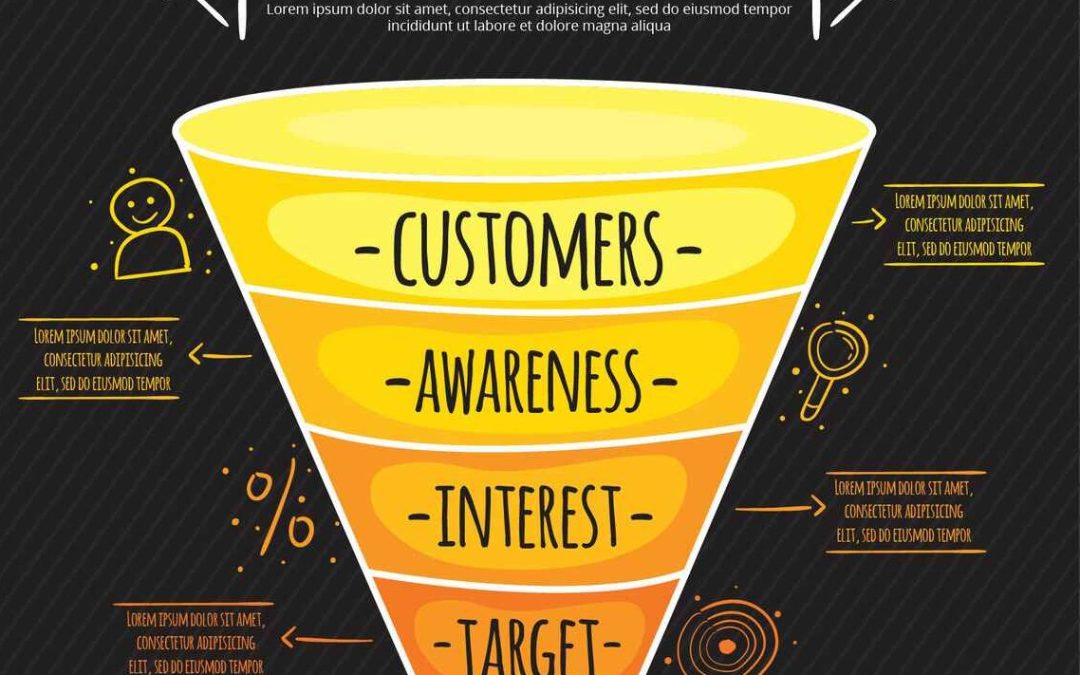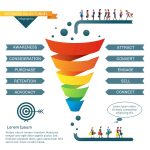One of the best things you can do to grow your business and make sure your marketing and sales efforts work is to keep track of your sales funnel. In today’s fast-paced and cutthroat business world, being able to handle your sales funnel well could make the difference between success and failure. But what does it truly mean to manage a sales funnel, and how can it help businesses acquire more leads, close more transactions, and make more money? Let’s talk about why it’s crucial to manage a sales funnel and how businesses can get the most out of it.
What does it mean to have a sales funnel?
A sales funnel is a term used in marketing to describe the steps that a potential customer takes from the first time they hear about a product or service to the time they decide to buy it. Companies use a step-by-step method to get leads to buy something. The point of a sales funnel is to get leads interested, keep them interested, and then make them buy something.
The funnel shows the several steps that the buyer goes through when making a choice. By properly managing the sales funnel, businesses can get the most out of their marketing, spend their resources wisely, and close more deals.
A standard sales funnel has four main steps:
- Awareness: This is the first step, when consumers learn about your service or product for the first time. They might learn about your brand through commercials, social media posts, or talking to people.
- Interest: At this point, leads are interested in what you have to offer. They might go to your website, read your blog posts, or interact with your content to learn more.
- Decision: At this point, leads are really considering whether or not to buy what you have to offer. They are weighing the pros and cons and seeing how it stacks up against what other businesses provide.
- Action: In this last stage, the lead performs what you want them to do, like buy something, sign up for a service, or agree to a contract.
How to Take Care of a Sales Funnel
When you manage a sales funnel, you need to keep an eye on the complete journey of leads through the funnel and make sure they get the correct amount of attention, care, and contact at each stage. This management system helps businesses find out where leads are in the buying process, position them in the appropriate sequence, and make their marketing and sales efforts better so that they are more likely to convert.
If you manage your sales funnel correctly, you won’t miss any leads. Companies can improve their operations and transform more leads into loyal customers by finding out where leads are falling off and fixing those problems.
Here are some crucial things to remember when operating a sales funnel:
- Taking care of leads at every step of the funnel to get them to buy.
- Giving leads materials and offers that are relevant to where they are in the process can help increase conversion rates.
- Following leads’ behaviors to make choices based on information that make the customer experience better.
Why is it vital to keep track of a sales funnel?
Taking care of your sales funnel is an important element of making sure your sales process works as well as it can. Here are some significant reasons why it’s necessary to keep an eye on your sales funnel for your organization to do well:
1. Helps you figure out which leads are the most important
Leads aren’t all the same. Some leads are more likely to become paying customers than others. When businesses know where their leads are in the buying process, they can better prioritize them. This is what good management of a sales funnel does. Businesses may get the most out of their money by focusing on leads that have a lot of promise and making sure that resources are used on the leads that are most likely to become customers.
For example, leads who are in the interest or decision stages may need more attention and face-to-face contact than leads who are in the awareness stage. Businesses may focus their efforts and not waste time and money on leads that aren’t likely to become customers if they grasp these differences.
2.It is important since it increases conversion rates.
A well-run sales funnel makes sure that leads have the right information and tools at each step of the buying process. By minimizing friction points, resolving objections, and providing the right offers at the right time, businesses may acquire more leads to turn into paying customers.
By managing the funnel correctly, businesses may make it easier for people to buy from them. This makes it less likely that they won’t buy.
3. Better use of resources
If sales teams know what stage each lead is in, they can use their resources more effectively. By treating all leads the same, sales funnel management helps businesses focus their efforts on those who are more likely to buy.
This strategic plan keeps sales teams from wasting time on prospects that need more attention or are unlikely to become clients.
4. Builds long-term ties with customers
A sales funnel isn’t only about making a sale; it’s also about keeping consumers for a long time. Businesses can get people to trust and be loyal to them by taking care of leads at every step of their journey and delivering them something of value.
Customers who feel appreciated and well-informed throughout the buying process are more likely to become repeat customers and brand champions. This will help the firm grow in the long run.
5. Provides useful knowledge
Companies may learn a lot about their leads by managing their sales funnel efficiently. By checking how well each stage is functioning, businesses can uncover weak spots in the funnel where leads are falling off or losing interest.
For instance, a substantial drop in the interest phase could imply that the message or content isn’t appealing to people who might wish to buy. These insights can help businesses make their planning more efficient and increase their conversion rates.
How to Properly Manage Your Sales Funnel
You need to know how to manage your sales funnel well in order to get the most out of it. Here are some tips for keeping your funnel in good shape:
1. Decide what steps to do in your funnel
The first step in managing your sales funnel is to clearly define the stages. Depending on what they offer, how they sell it, and who they want to sell it to, different firms may have different funnels.
Make sure that the steps in your funnel match the steps in the buyer’s journey and make it easy for them to go from learning about your product to buying it. This makes it apparent what stage your sales and marketing teams should be working on at any given time.
2. Find the Right Leads
The most crucial thing about a great sales funnel is getting the right leads. A mix of SEO (Search Engine Optimization), paid ads, social media marketing, and content marketing is usually used to do this. Writing high-quality content, including blog posts, eBooks, and videos, can help you get potential customers at the top of your funnel and into your pipeline.
Make sure that your marketing efforts are focused at the right people so that you get leads that are truly interested in what you have to offer.
3. Ambush leads by talking to direct1y with them
Once you have a lead, the next step is to keep them interested by talking to them in a way that is unique to them. Sending tailored emails, making follow-up calls, and offering leads content that is relevant to them can all help you build a relationship with them and address any issues or objections they may have.
For example, sending the lead educational content or product demos can help them go farther down the funnel and get closer to making a purchase.
4. Make sure your leads are good
Some leads aren’t ready to buy straight away. You need to qualify leads to check if they are ready to buy in order to operate a sales funnel. Use a lead scoring system that provides leads scores based on how involved they are, how many conversations they have, and what they do.
Leads with high scores are more likely to buy something, therefore you should spend more time nurturing them and less time on leads with poor scores.
5. Use marketing that runs on its own
Marketing automation tools can help you make your sales funnel easier by handling tasks like sending follow-up emails, nurturing prospects, and sending reminders. Automation systems can handle easy, repetitive tasks, so your personnel may focus on more critical and difficult ones.
HubSpot, Marketo, and Pardot are all popular marketing automation tools that may help you develop your business and handle a lot of leads while still making each one feel personal.
6. Get the most out of conversions
When leads are ready to buy, it’s crucial to optimize for conversions. You may offer the lead great discounts, specials that are only good for a short time, or free trials to persuade them to buy.
Throughout the funnel, your calls to action should be clear, your checkout process should be simple, and your value proposition should be easy to identify.
7. Check out your funnel and make it better.
If you check at your sales funnel often, you can spot faults and gaps in it. You can use tools like Google Analytics, CRM software, and sales reports to see how leads move through the funnel.
You can make better and more efficient decisions about how to manage your sales funnel by looking at conversion rates, engagement levels, and drop-off points.
Important Sales Funnel Metrics to Watch: To make sure your sales funnel is working, you need to check on key performance indicators (KPIs) on a frequent basis. Some of the most essential metrics for a sales funnel are:
- The conversion rate is the number of leads who become paying customers.
- Lead Velocity Rate (LVR): How quickly new leads enter the funnel.
- Average Deal Size: The average value of a deal that has been closed.
- Length of the Sales Cycle: The average amount of time it takes for someone to learn about a product and then buy it.
- Customer Acquisition Cost (CAC): The cost of getting a new customer through your sales funnel.
- By keeping an eye on this data and making modifications when necessary, businesses can see how well their funnel is performing.
Tools for Keeping Track of the Sales Funnel
There are a lot of ways to make it easier and more efficient to manage your sales funnel. These platforms have tremendous capabilities for tracking leads, automating tasks, and checking on performance. These are some well-known tools for keeping track of sales funnels:
- HubSpot CRM is a complete system for keeping track of leads, sales, and marketing tasks.
- Salesforce is a cloud-based CRM that includes great statistics and tracking for sales funnels.
- Pipedrive is a simple CRM that lets you keep track of leads and observe how they are advancing through the sales process.
- Marketo is a solution that automates marketing tasks and helps you take care of potential customers and make the sales funnel process as smooth as possible.
- These tools could make it much easier to keep track of your sales funnel, which will help you attract more customers to buy and work faster.
Conclusion
Sales funnel management is something that businesses need to do if they want to optimize their sales process, acquire more conversions, and build long-term relationships with clients. By recognizing the stages of the funnel, taking care of leads the right way, and using the right tools and procedures, businesses can speed up their sales processes, boost their productivity, and encourage growth. If you utilize the right strategy and keep an eye on things, managing your sales funnel could be a terrific way to help your business succeed.














